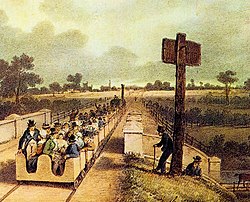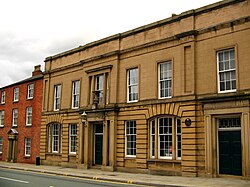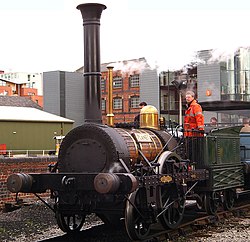Moorish Arch looking from the Tunnel
Autor/Urheber:
Shortlink:
Quelle:
Größe:
1024 x 836 Pixel (316897 Bytes)
Beschreibung:
The Moorish Arch in the cuttings at Edge Hill on the Liverpool and Manchester Railway, where locomotives were originally attached and detached from trains.
The arch, designed by the Liverpool architect John Foster, responded to the railway directors' desire for a monumental ornate structure to mark the entrance of the railway into the city. It also housed the two steam engines, one on either side, that powered the cable railway apparatus which was used to haul wagons with goods from the docks up to Edge Hill through the Wapping tunnel, and passenger carriages up the final stretch from Edge Hill to the railway terminus at Crown Street. First class passengers could also join the trains here, conveyed by horse-drawn carriages from Dale Street in the city centre. Steam and smoke from the engines was ducted through flues in the rockface on either side to two tall chimneys, nicknamed "the Pillars of Hercules", at the other end of the cutting.
The arch was demolished in 1864, when the right hand (south) side of the cutting was widened out. (Another source says the late 1830s [1], p. 19)
The arch, designed by the Liverpool architect John Foster, responded to the railway directors' desire for a monumental ornate structure to mark the entrance of the railway into the city. It also housed the two steam engines, one on either side, that powered the cable railway apparatus which was used to haul wagons with goods from the docks up to Edge Hill through the Wapping tunnel, and passenger carriages up the final stretch from Edge Hill to the railway terminus at Crown Street. First class passengers could also join the trains here, conveyed by horse-drawn carriages from Dale Street in the city centre. Steam and smoke from the engines was ducted through flues in the rockface on either side to two tall chimneys, nicknamed "the Pillars of Hercules", at the other end of the cutting.
The arch was demolished in 1864, when the right hand (south) side of the cutting was widened out. (Another source says the late 1830s [1], p. 19)
Lizenz:
Public domain
Credit:
T.T. Bury (1831), Coloured Views on the Liverpool and Manchester Railway. London: Ackermann & Co; plate 10.
This scan/photograph from the Stapleton Collection, via the Bridgeman Art Library (STC 122454) and Artfinder.com (description page, image)
This scan/photograph from the Stapleton Collection, via the Bridgeman Art Library (STC 122454) and Artfinder.com (description page, image)
Relevante Bilder
Relevante Artikel
Liverpool and Manchester RailwayDie Liverpool and Manchester Railway (L&MR) war eine Eisenbahngesellschaft in Großbritannien. Sie baute zwischen Liverpool und Manchester eine Eisenbahnstrecke, die das Referenzmodell für die folgende Entwicklung der Eisenbahn weltweit wurde. Erstmals fuhren auf ihr sämtliche Züge nach festem Fahrplan, ausschließlich von Dampflokomotiven gezogen und es war zugleich die erste Strecke mit durchgehend zweigleisigem Betrieb – einem Gleis für jede Fahrtrichtung – und von Anfang an für den öffentlichen Verkehr vorgesehen. .. weiterlesen
















